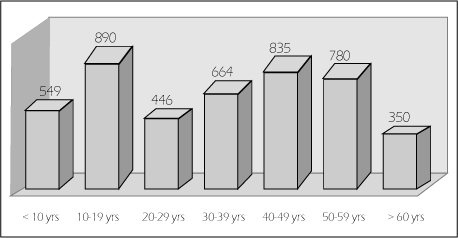J Cerebrovasc Endovasc Neurosurg.
2012 Jun;14(2):75-78. 10.7461/jcen.2012.14.2.75.
Prevalence and Epidemiological Features of Moyamoya Disease in Korea
- Affiliations
-
- 1Department of Neurosurgery, College of Medicine, Catholic University, Seoul, Korea.
- 2Department of Neurosurgery, Hallym University College of Medicine, Seoul, Korea.
- 3Department of Neurosurgery, Yeouido St. Mary's Hospital, College of Medicine, Catholic University, Catholic Neuroscience Center, Seoul, Korea. hkrha@catholic.ac.kr
- KMID: 1808439
- DOI: http://doi.org/10.7461/jcen.2012.14.2.75
Abstract
OBJECTIVE
The objectives of the present study were to investigate the annual detection rate of patients with Moyamoya disease (MMD) and to describe the prevalence and epidemiological features of the Moyamoya patients in Korea.
MATERIALS AND METHODS
The authors analyzed the epidemiological data of Korean patients taken from the National Health Insurance Corporation in Korea among Moyamoya patients who were treated from 2004 until 2008.
RESULTS
Based on 2004 data, 2,539 MMD patients were treated in Korea and the prevalence rate was 5.2 per 100,000 people. There were 2,987 in 2005, 3,429 in 2006, 4,051 in 2007, and 4,517 cases in 2008, and the prevalence rates per 100.000 people were 6.3, 7.0, 8.6, and 9.1, for those respective years. This represents an annual increase of 15% of new cases during this period. In 2008, 466 people were newly diagnosed with MMD, representing an incidence rate of 1 per 100,000 persons. The gender ratio was 1,547 men (34%) and 2,970 women (66%). Women had a higher incidence rate than men (1.94 times). There were two age peaks: teenagers and those in their forties.
CONCLUSION
The present study shows that the number of Moyamoya patients in Korea is increasing. This increase could partly be explained by a recent increase in newly diagnosed cases, suggesting that a more careful consideration of the disease and better diagnostic techniques should be promoted among clinicians.
Keyword
MeSH Terms
Figure
Cited by 2 articles
-
Epidemiology of Moyamoya Disease in Korea: Based on National Health Insurance Service Data
Tackeun Kim, Heeyoung Lee, Jae Seung Bang, O-Ki Kwon, Gyojun Hwang, Chang Wan Oh
J Korean Neurosurg Soc. 2015;57(6):390-395. doi: 10.3340/jkns.2015.57.6.390.A Recent Update of Clinical and Research Topics Concerning Adult Moyamoya Disease
Jin Pyeong Jeon, Jeong Eun Kim
J Korean Neurosurg Soc. 2016;59(6):537-543. doi: 10.3340/jkns.2016.59.6.537.
Reference
-
1. Chiu D, Shedden P, Bratina P, Grotta JC. Clinical features of moyamoya disease in the United States. Stroke. 1998. 07. 29(7):1347–1351.
Article2. Choi KS. Suzuki J, editor. Moyamoya Disease in Korea. A Cooperative Study. Advance in surgery for cerebral stroke. 1988. Berlin Heidelberg New York Tokyo: Springer;107–109.3. Han DH, Kwon OK, Byun BJ, Choi BY, Choi CW, Choi JU, et al. A Co-Operative Study : Clinical Characteristics of 334 Korean Patients with Moyamoya Disease Treated at Neurological Institute(1976-1994). The Korean Society for Cerebrovascular Disease. Acta Neurochir (Wien). 2000. 142(11):1263–1273. discussion 1273-4.4. Hung CC, Tu YK, Su CF, Lin LS, Shih CJ. Epidemiological study of Moyamoya disease in Taiwan. Clin Neurol Neurosurg. 1997. 10. 99:Suppl 2. S23–S25.
Article5. Ikezaki K, Han DH, Kawano T, Kinukawa N, Fukui M. A Clinical Comparison of definite Moyamoya Disease Between South Korea and Japan. Stroke. 1997. 12. 28(12):2513–2517.
Article6. Kudo T. Spontaneous occlusion of the circle of Willis: A disease apparently confined to Japanese. Neurology. 1968. 05. 18(5):485–496.
Article7. Kuriyama S, Kusaka Y, Fujimura M, Wakai K, Tamakoshi A, Hashimoto S, et al. Prevalence and Clinicoepidemiological Features of Moyamoya Disease in Japan. Findings From a Nationwide Epidemiological Survey. Stroke. 2008. 01. 39(1):42–47.8. Miao W, Zhao PL, Zhang YS, Liu HY, Chang Y, Ma J, et al. Epidemiological and clinical features of Moyamoya disease in Nanjing, China. Clinical Neurol Neurosurg. 2010. 04. 112(3):199–203.
Article9. Smith ER, Scott RM. Moyamoya: Epidemiology, Presentation, and Diagnosis. Neurosurg Clin N Am. 2010. 07. 21(3):543–551.
Article10. Suzuki J, Takaku A. Cerebrovascular "moyamoya" disease: disease showing abnormal net-like vessels in base of brain. Arch Neurol. 1969. 03. 20(3):288–299.11. Takeuchi K, Shimizu K. Hypoplasia of the bilateral internal carotid arteries. No to shinkei Journal. 1957. 9(1):37–43.12. Uchino K, Johnston SC, Becker KJ, Tirschwell DL. Moyamoya disease in Washington State and California. Neurology. 2005. 09. 65(6):956–958.
Article13. Wakai K, Tamakoshi A, Ikezaki K, Fukui M, Kawamura T, Aoki R, et al. Epidemiological features of moyamoya disease in Japan : findings from a nationwide survey. Clin Neurol Neurosurg. 1997. 10. 99:suppl 2. S1–S5.14. Yonekawa Y, Gotoh Y, Ogata N. Barnett HJM, editor. Moyamoya disease: diagnosis, treatment and recent achievement. Stroke: pathophysiology, diagnosis and management. 1992. New York: Churchill-Livingstone;721–727.15. Yonekawa Y, Ogata N, Kaku Y, Taub E, Imhof HG. Moyamoya disease in Europe, past and present status. Clin Neurol Neurosurg. 1997. 10. 99:Suppl 2. S58–S60.
Article




